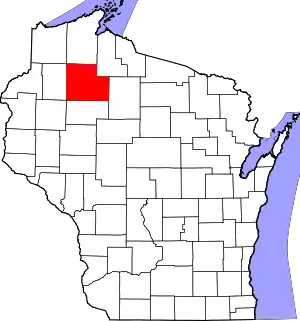Hayward, Wisconsin
Hayward is a city in Sawyer County, Wisconsin, United States, next to the Namekagon River. Its population was 2,318 at the 2010 census. It is the county seat of Sawyer County. The city is surrounded by the Town of Hayward. The City of Hayward was formally organized in 1883.[9]
Hayward | |
|---|---|
City | |
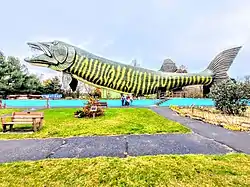 | |
 Flag | |
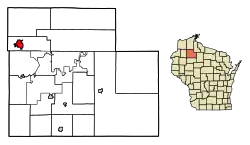 Location of Hayward in Sawyer County, Wisconsin | |
 Hayward Location of the city of Hayward within Sawyer County, Wisconsin | |
| Coordinates: 46°0′36″N 91°28′50″W | |
| Country | |
| State | |
| County | Sawyer |
| Formally Organized | 1883 |
| Government | |
| • Mayor | Charlie Munich[1] |
| Area | |
| • Total | 3.40 sq mi (8.81 km2) |
| • Land | 3.17 sq mi (8.20 km2) |
| • Water | 0.23 sq mi (0.61 km2) |
| Population | |
| • Total | 2,318 |
| • Estimate (2019)[4] | 2,311 |
| • Density | 729.71/sq mi (281.72/km2) |
| Time zone | UTC-6 (Central (CST)) |
| • Summer (DST) | UTC-5 (CDT) |
| ZIP codes | 54843[5] |
| Area code(s) | 715 and 534[6] |
| FIPS code | 55-33450[7] |
| GNIS feature ID | 1583370[8] |
| Website | www.cityofhaywardwi.gov |
History
Early history
Hayward was "named for Anthony Judson Hayward, a lumberman who located the site for building a sawmill, around which the town grew."[10][11]
Logging began in the late 1850s. Loggers came from Cortland County, New York, Carroll County, New Hampshire, Orange County, Vermont, Down East Maine in what is now Washington County, Maine, and Hancock County, Maine. These were "Yankee" migrants, descended from the English Puritans who had settled New England during the 1600s. They were mostly members of the Congregational Church.[12] From the 1890s, immigrants came from a variety of countries such as Germany, Norway, Poland, Italy, Ireland, Czechoslovakia, and Sweden.
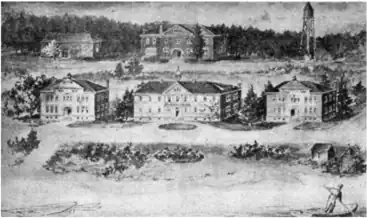
Hayward Indian Residential School
In 1901, the Hayward Indian Residential School was established in Hayward. It was founded to assimilate indigenous children into white Christian American culture. Most of the students were Ojibwe and came from the Lac Courte Oreilles Reservation ten miles away from the school. The school operated until 1934, when it closed due to being understaffed, underfunded, and overcrowded. During its operation, thousands of students passed through the school.[13] Some were taken forcibly from their families.[14] At the school, children were forced to take on Christian names, cut their hair, wear military style uniforms, and march in military formations.[13] Boys and girls were strictly segregated in separate buildings.[15]
The curriculum focused on English language, Christian religion, and industrial labor. Provision of teachers was so poor that few students graduated, and graduation certificates were withheld from students who were thought likely to return to their reservations instead of assimilating into white society. The school was funded in part by the government and in part by the labor of the children in agriculture and sewing. Male children cleared over 260 acres for cultivation. Girls were trained as housewives and lived in the "Homestead Cottage", where a female teacher taught them how to run a household. The girls sold their sewing products to support the school and prepared meals for the other students. In the first decade of the school's operation, girls were encouraged to practice Native beadwork styles, but by 1910, this had been discontinued.[13]
Overcrowding and poor sanitation endangered the students' health. Dishes were rarely cleaned, students slept two to a bed, and during the winter, they crowded into small rooms for indoor activities because the school had no gymnasium. Children were served moldy bread, and most of the milk the children produced from the dairy herd was sold rather than fed to the children.[13] These poor health conditions led to high rates of disease. The death rate during the 1918 flu pandemic was 10 times higher than the Wisconsin average.[16] Students also died from epidemics of measles and pneumonia.[13] Some students were sexually abused by the teachers.[14]
For speaking their Native languages, students were punished with beatings, public humiliation, extra chores, and confinement in the school jail. The school jail was a cell with bars in the basement of the boy's dormitory, where children were fed only bread and water.[13] Other students were punished by being forced to kneel on marbles for hours.[14] Hayward students sometimes went out into the woods on the weekends and spoke Ojibwe together since it was forbidden in school. On one occasion, a secret drum dance was held, where students prepared by secretly sewing jingles onto their dresses and practicing their singing at night. The superintendents caught the students and punished them by burning their drums, hitting their knuckles, and forcing the girls to wear signs around their necks reading, "I will not squaw dance".[17] Due to the poor conditions and harsh discipline, runaways were common; in 1920 alone, 69 children ran away from the school.[13]
The school closed in 1934 and was converted to the Hayward Area Memorial Hospital.[18]
Geography
Hayward is located at 46°0′36″N 91°28′50″W (46.01, -91.480556).[19]
According to the United States Census Bureau, the city has an area of 3.36 square miles (8.70 km2), of which 0.23 sq mi (0.60 km2) is covered by water.[20]
Hayward is 71 miles southeast of Superior, 27 miles northeast of Spooner, about 107 miles north of Eau Claire, and 57 miles southwest of Ashland.
Climate
| Climate data for Hayward, Wisconsin (1991–2020 normals, extremes 1893–present) | |||||||||||||
|---|---|---|---|---|---|---|---|---|---|---|---|---|---|
| Month | Jan | Feb | Mar | Apr | May | Jun | Jul | Aug | Sep | Oct | Nov | Dec | Year |
| Record high °F (°C) | 56 (13) |
60 (16) |
81 (27) |
89 (32) |
98 (37) |
106 (41) |
108 (42) |
100 (38) |
96 (36) |
86 (30) |
75 (24) |
59 (15) |
108 (42) |
| Mean maximum °F (°C) | 42.5 (5.8) |
47.3 (8.5) |
63.1 (17.3) |
77.3 (25.2) |
85.9 (29.9) |
89.9 (32.2) |
91.8 (33.2) |
90.2 (32.3) |
86.5 (30.3) |
76.1 (24.5) |
62.6 (17.0) |
45.8 (7.7) |
93.5 (34.2) |
| Average high °F (°C) | 24.0 (−4.4) |
29.8 (−1.2) |
42.4 (5.8) |
55.8 (13.2) |
69.3 (20.7) |
77.9 (25.5) |
81.8 (27.7) |
79.3 (26.3) |
71.6 (22.0) |
57.3 (14.1) |
41.4 (5.2) |
28.7 (−1.8) |
54.9 (12.7) |
| Daily mean °F (°C) | 13.5 (−10.3) |
17.8 (−7.9) |
30.0 (−1.1) |
43.0 (6.1) |
55.6 (13.1) |
64.7 (18.2) |
68.7 (20.4) |
66.5 (19.2) |
59.4 (15.2) |
46.3 (7.9) |
32.4 (0.2) |
19.7 (−6.8) |
43.1 (6.2) |
| Average low °F (°C) | 2.9 (−16.2) |
5.8 (−14.6) |
17.6 (−8.0) |
30.1 (−1.1) |
41.9 (5.5) |
51.6 (10.9) |
55.5 (13.1) |
53.7 (12.1) |
47.1 (8.4) |
35.2 (1.8) |
23.4 (−4.8) |
10.7 (−11.8) |
31.3 (−0.4) |
| Mean minimum °F (°C) | −25.5 (−31.9) |
−21.9 (−29.9) |
−11.2 (−24.0) |
12.1 (−11.1) |
24.2 (−4.3) |
34.1 (1.2) |
42.1 (5.6) |
39.2 (4.0) |
27.9 (−2.3) |
18.0 (−7.8) |
1.8 (−16.8) |
−17.7 (−27.6) |
−28.7 (−33.7) |
| Record low °F (°C) | −45 (−43) |
−52 (−47) |
−40 (−40) |
−6 (−21) |
11 (−12) |
24 (−4) |
32 (0) |
29 (−2) |
15 (−9) |
1 (−17) |
−21 (−29) |
−42 (−41) |
−52 (−47) |
| Average precipitation inches (mm) | 0.89 (23) |
0.89 (23) |
1.46 (37) |
2.70 (69) |
3.99 (101) |
4.20 (107) |
4.15 (105) |
3.94 (100) |
3.97 (101) |
3.15 (80) |
1.67 (42) |
1.26 (32) |
32.27 (820) |
| Average snowfall inches (cm) | 12.0 (30) |
10.4 (26) |
10.3 (26) |
5.5 (14) |
0.6 (1.5) |
0.0 (0.0) |
0.0 (0.0) |
0.0 (0.0) |
0.0 (0.0) |
0.8 (2.0) |
7.3 (19) |
12.5 (32) |
59.4 (151) |
| Average precipitation days (≥ 0.01 in) | 8.8 | 6.9 | 7.9 | 11.2 | 12.5 | 13.3 | 11.6 | 10.8 | 11.8 | 12.4 | 9.5 | 10.1 | 126.8 |
| Average snowy days (≥ 0.1 in) | 8.6 | 6.3 | 4.7 | 2.6 | 0.2 | 0.0 | 0.0 | 0.0 | 0.0 | 0.8 | 4.9 | 8.5 | 36.6 |
| Source: NOAA[21][22] | |||||||||||||
Demographics
| Census | Pop. | Note | %± |
|---|---|---|---|
| 1890 | 1,349 | — | |
| 1920 | 1,302 | — | |
| 1930 | 1,207 | −7.3% | |
| 1940 | 1,571 | 30.2% | |
| 1950 | 1,577 | 0.4% | |
| 1960 | 1,540 | −2.3% | |
| 1970 | 1,457 | −5.4% | |
| 1980 | 1,698 | 16.5% | |
| 1990 | 1,897 | 11.7% | |
| 2000 | 2,129 | 12.2% | |
| 2010 | 2,318 | 8.9% | |
| 2019 (est.) | 2,311 | [4] | −0.3% |
| U.S. Decennial Census[23] | |||
2010 census
As of the census[3] of 2010, 2,318 people, 1,048 households, and 550 families resided in the city. The population density was 740.6 inhabitants per square mile (285.9/km2). The 1,227 housing units had an average density of 392.0 per square mile (151.4/km2). The racial makeup of the city was 83.3% White, 0.4% African American, 11.8% Native American, 0.9% Asian, 0.3% from other races, and 3.2% from two or more races. Hispanics or Latinos of any race were 2.5% of the population.
Of the 1,048 households, 27.6% had children under 18 living with them, 32.5% were married couples living together, 14.0% had a female householder with no husband present, 5.9% had a male householder with no wife present, and 47.5% were not families. About 41.7% of all households were made up of individuals, and 20.0% had someone living alone who was 65 or older. The average household size was 2.10 and the average family size was 2.80.
The median age in the city was 39.8 years. 23.7% of residents were under the age of 18; 8.5% were between the ages of 18 and 24; 23.6% were from 25 to 44; 23.5% were from 45 to 64; and 20.8% were 65 years of age or older. The gender makeup of the city was 47.5% male and 52.5% female.
2000 census
As of the census[7] of 2000, 2,129 people, 960 households, and 530 families were residing in the city. The population density was 717.2/sq mi (276.8/km2). The1,064 housing units had an average density of 358.4/sq mi (138.3/km2). The racial makeup of the city was 89.62% White, 0.14% African American, 8.08% Native American, 0.66% Asian, 0.56% from other races, and 0.94% from two or more races. About 0.85% of the population were Hispanics or Latinos of any race.
Of the 960 households, 26.8% had children under 18 living with them, 38.2% were married couples living together, 13.9% had a female householder with no husband present, and 44.8% were not families. About 39.8% of all households were made up of individuals, and 19.1% had someone living alone who was 65 or older. The average household size was 2.09, and the average family size was 2.78.
In the city, the age distribution was 22.6% under 18, 8.7% from 18 to 24, 25.5% from 25 to 44, 20.9% from 45 to 64, and 22.4% who were 65 or older. The median age was 40 years. For every 100 females, there were 88.2 males. For every 100 females 18 and over, there were 81.9 males.
The median income for a household in the city was $28,421, and for a family was $36,287. Males had a median income of $30,174 versus $20,769 for females. The per capita income for the city was $16,658. About 10.6% of families and 14.5% of the population were below the poverty line, including 19.5% of those under age 18 and 7.1% of those age 65 or over.
Government
Hayward is the county seat of Sawyer County. The mayor as of 2021 was Charlie Munich.[24]
| Year | Republican | Democratic | Third parties |
|---|---|---|---|
| 2020 | 57.3% 661 | 40.7% 469 | 2.0% 23 |
| 2016 | 54.5% 558 | 38.4% 393 | 7.1% 73 |
| 2012 | 46.8% 477 | 52.4% 534 | 0.9% 9 |
| 2008 | 41.9% 438 | 56.7% 592 | 1.4% 15 |
| 2004 | 52.3% 566 | 46.4% 502 | 1.3% 14 |
| 2000 | 50.4% 468 | 43.6% 405 | 5.9% 55 |
Transportation
Major highways
U.S. Highway 63, Wisconsin Highway 27, Wisconsin Highway 77, and County Highway B are the main routes in the community.
Bus
Hayward has a public bus service, Namekagon Transit, which has three separate lines. Route 30 starts at Walmart and runs through the town with stops at Sawyer County Courthouse and Marketplace Foods, and then runs to the transfer center at the Sevenwinds Casino, where one can transfer to or from Lines 40 or 60. Route 40 runs in a complete circuit route past Round Lake and to some other rural neighborhoods around the areas, and then arrives back at the transfer center. Route 60 runs south from the casino, making two stops, then diverging into two lines at the LCO Country Store. One heads on CTH-K, and eventually terminates in the North Woods Beach neighborhood; the other heads on CTH-E and terminates in the unincorporated community of Reserve. Namekagon Transit also has door-stop services in Sawyer, Barron, Washburn, and some parts of Bayfield counties.
Airport
Sawyer County Airport serves Hayward and the surrounding communities.
Tourism
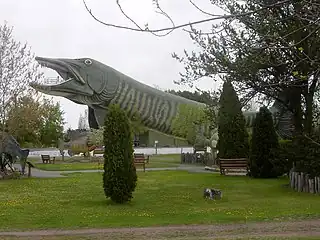
Hayward is a popular fishing destination because of the many lakes in the area, including Lac Courte Oreilles, Grindstone Lake, Round Lake, Moose Lake, Spider Lake, Windigo Lake, and the Chippewa Flowage, which are known for yielding trophy-sized muskellunge, northern pike, walleye, and smallmouth bass. It is also home to the "Quiet Lakes" (Teal, Ghost and Lost Land Lakes), which do not allow water sports.
The National Fresh Water Fishing Hall of Fame is in Hayward. It contains a 143-foot (44 m) fiberglass muskie, the world's largest fiberglass structure.[26] Tourists can climb up into the fish's mouth and look over the town, as well as Lake Hayward. In addition to fishing, Hayward is also a hot spot for deer hunting, golfing, cross-country skiing, snowmobiling, canoeing, kayaking, horseback riding, and road and mountain biking.
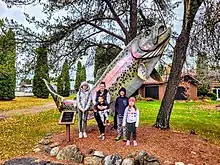
Sawyer County has over 600 miles of groomed snowmobile trails, including 335 miles that run through county forests and connect with trails in adjoining counties.[27][28]
ATV (quad bikes) riding along county forest logging roads is permitted. About 95.7 miles of state-funded ATV trails are available for winter use and 80.8 miles are for summer use. State-owned trails include the Tuscobia Trail (51 miles), which runs from the Flambeau River to the western county line and the Dead Horse Connector (38 miles) in the eastern Flambeau Forest. The trail system also connects to 140 miles of trail within the Chequamegon National Forest. Hayward allows ATVs on some city roads.[27][29]
The annual Chequamegon Fat Tire Festival is the nation's largest mass-start mountain-bike race. The first Fat Tire Festival was held in 1983 with 27 riders, and in 2008, the race was capped at 2,500 competitors. The two main races include the 40-mile "Chequamegon 40", and the 16-mile "Short and Fat".[30]
Participants in the annual Lumberjack World Championships compete in a variety of lumberjack games, such as log rolling, chopping, sawing, and chainsaw events.
Hayward hosts the American Birkebeiner cross-country skiing race, North America's largest cross-country ski marathon.[31] The race started in 1973. No U.S. Ski Team members were in it, or any foreign skiers. Then unknown, it now has over 13,000 skiers race every year.[32] It is one of Hayward's largest and most popular tourist attractions.
The Lac Courte Oreilles Band of Ojibwe host several pow-wows throughout the year. North America's largest pow-wow is held annually on the third weekend of July in Hayward. The Honor the Earth Pow-wow honors Mother Earth and the Creator.[33]
The Park Theatre is a performing arts center in Hayward, on Highway 63, operated by the Cable Hayward Area Arts Council. A variety of musical and artistic performances are presented throughout the year.
Hayward Wolfpack FC, an amateur soccer club, is based in Hayward.[34] Founded in 2017, it competed in the Duluth Amateur Soccer League in 2018. In 2019, the Wolfpack became a founding member of the Wisconsin Primary Amateur Soccer League, a United States Adult Soccer Association and WSL-sanctioned league operating in western Wisconsin.[35]
Media
Print
- The Sawyer County Record is the local newspaper, published every Wednesday.
Radio
Education
Hayward High School and Hayward Middle School serve the community. Lac Courte Oreilles Ojibwa Community College offers several degrees.
Notable people
- Fritz Ackley, MLB player
- Harry Blackmun, U.S. Supreme Court justice, had a summer home on Spider Lake.[36]
- Al Capone, Chicago gangster, owned a hideaway-retreat near Hayward/Couderay in the 1920s and 1930s.[37]
- Nate DeLong, NBA player
- Jim Denomie, artist
- Sean Duffy, reality television star, ESPN commentator, U.S. House of Representatives, representing the 7th District of Wisconsin
- John H. Hellweg, Wisconsin state legislator and businessman
- Dan Plante, NHL player
- Daniel E. Riordan, Wisconsin state senator
- Randy Sabien, musician/songwriter
- J. R. Salzman, world-champion logroller
See also
References
- "City Officials". cityofhaywardwi.gov. Retrieved November 5, 2014.
- "2019 U.S. Gazetteer Files". United States Census Bureau. Retrieved August 7, 2020.
- "U.S. Census website". United States Census Bureau. Retrieved November 18, 2012.
- "Population and Housing Unit Estimates". United States Census Bureau. May 24, 2020. Retrieved May 27, 2020.
- US Postal Service – ZIP Codes
- "North American Numbering Plan Administration". Archived from the original on April 2, 2011. Retrieved April 5, 2011.
- "U.S. Census website". United States Census Bureau. Retrieved January 31, 2008.
- "US Board on Geographic Names". United States Geological Survey. October 25, 2007. Retrieved January 31, 2008.
- "About the City". cityofhaywardwi.gov. Retrieved June 27, 2023.
- "Origin of the name Hayward". Wisconsin Historical Society, Dictionary of Wisconsin History.
- Chicago and North Western Railway Company (1908). A History of the Origin of the Place Names Connected with the Chicago & North Western and Chicago, St. Paul, Minneapolis & Omaha Railways. p. 178.
- History of Education in Sawyer County, Wisconsin by J. G. Adams (M.E. Granger, 1902)
- Overturf, Titus (2009). The Hayward Indian School: Realities of an Off-Reservation Boarding School. University of Wisconsin Eau Claire.
- "Ish Kode Bish Iki / Morris (Doc) Mosay". The Forgiveness Project.
- "Photograph: Hayward Indian School". Wisconsin Historical Society. December 2003.
- Lawson, Kristin L. (2008). Healing the Frontier: Catholic Sisters, Hospitals, and Medicine Men in the Wisconsin Big Woods, 1880-1920. p. 211.
- Vennum, Thomas (2008). Just Too Much of an Indian: Bill Baker, Stalwart in a Fading Culture. LaPointe, WI: Just Too Much of an Indian Press. pp. 66–68.
- "Hayward (Wisconsin) Indian School". FamilySearch.
- "US Gazetteer files: 2010, 2000, and 1990". United States Census Bureau. February 12, 2011. Retrieved April 23, 2011.
- "US Gazetteer files 2010". United States Census Bureau. Retrieved November 18, 2012.
- "NowData – NOAA Online Weather Data". National Oceanic and Atmospheric Administration. Retrieved September 25, 2021.
- "Station: Hayward RS, WI". U.S. Climate Normals 2020: U.S. Monthly Climate Normals (1991-2020). National Oceanic and Atmospheric Administration. Retrieved September 25, 2021.
- "Census of Population and Housing". Census.gov. Retrieved June 4, 2015.
- "City Officials". City of Hayward, Wisconsin. Retrieved November 17, 2021.
- "Wisconsin election results". Lubar Center for Public Policy and Civic Education. Retrieved November 12, 2021.
- Dregni, Eric (2006). Midwest Marvels: Roadside Attractions Across Iowa, Minnesota, the Dakotas, and Wisconsin. U of Minnesota Press. p. 365. ISBN 978-0-8166-4290-8.
- "Sawyer County Snowmobile & ATV Alliance".
- "Wisconsin Department of Natural Resources snowmobiling information" (PDF). Archived from the original (PDF) on March 23, 2015. Retrieved April 19, 2015.
- "Sawyer County Land & Water Use Planning 2014 to 2020" (PDF). Archived from the original (PDF) on March 23, 2015. Retrieved April 19, 2015.
- Fat Tire Festival website
- Kaye, Nick (January 27, 2006). "Not All Downhill (Not Even Mostly)". The New York Times.
- "About the American Birkebeiner Ski Foundation and History". birkie.com. Retrieved November 5, 2014.
- "Pow-wow".
- Ali, Sam (March 11, 2021). "Hayward Wolfpack FC Reveal New Branding, Logo". Fox21Online. Retrieved September 23, 2021.
- "Hayward Wolfpack FC Returns To The WPASL". April 1, 2021.
- Greenhouse, Linda (2005). Becoming Justice Blackmun. Times Boks. p. 248. ISBN 978-0-8050-7791-9.
- Morey, Joe (February 2, 2010). "Councilman reports on Hideout and other issues at the Directors Meeting". Archived from the original on March 5, 2012.
External links
- Official website
- Hayward Area Chamber of Commerce
- Sawyer County Record – local newspaper
- Sanborn fire insurance maps: 1892 1898 1909
